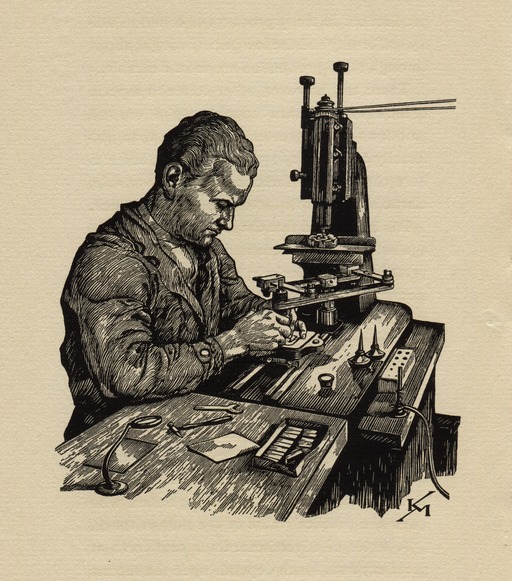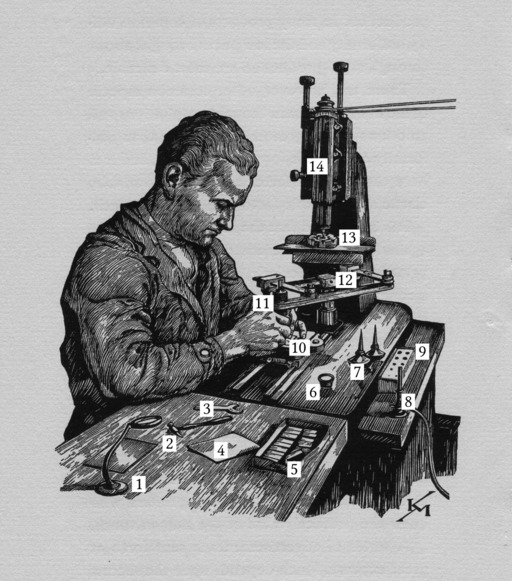This is a woodcut by Karl Mahr as published in the Bauer Type Foundry book Human Touch. (NY: The Spiral Press, 1937). This engraving appeared originally in Der Druckbuchstabe: Sein Werdegang in der Schriftgießerei dargestellt in Holzschnitten und Versen . ([no location, but Mahr in Frankfurt a. M.]: Verein Deutscher Schriftgießereien E.D., 1928). Go up one level for a discussion of this work as a whole, and for general works on type-making.

The image above is a reduced-scale version of the original scan. It is 2048 pixels wide, and quite enough for most purposes. Here is a full-resolution version (79 Megabytes): bauer-human-touch-1937-1200rgb-machine-engraver-crop-6700x7600.png
This engraving depicts an engraver engaged in engraving a typecasting matrix using a pantograph engraving machine. The make of the machine is not specified, but it is of the same general configuration as the Michael Kampf A.G. machine still in use at the Offizin Parnassia Vättis. See, for example, the photograph of this machine on the Parnassia flickr photostream at http://www.flickr.com/photos/parnassia/6843624910/in/photostream
Below is an annotated version identifying the tools shown.

1. A magnifier. I presume that this would be useful in examining the Working Pattern (see below), while the Loup (item #6) would be more appropriate for examining the matrix.
2. A very light Hammer. Purpose unknown to me.
3. A Wrench. Presumably for adjusting the machine and/or securing the pattern and matrix holders in it.
4. Papers on the Bench. Purposes unknown to me.
5. Matrices. The woodcut would seem to indicate that these are matrices which have already been engraved.
6. A Loupe for examining the Matrices.
7. Oil Cans. It is an interesting coincidence that in the photograph of the Michael Kampf A.G. pantograph at the Offizin Parnassia two oil cans are also shown.
8. A Bunsen (naturally aspirated) burner. The purpose of this burner is unknown to me, as heat is not generally required in the machine engraving process.
9. A block with holes which, I presume, hold Tracers of various sizes for use in the Pantograph. A block very much like this one (with Tracers in it) is shown in the photograph of the Michael Kampf A.G. pantograph at the Offizin Parnassia
10. A Working Pattern held in a workholding apparatus in the Pantograph.
11. The workman guiding a Tracer in the Working Pattern.
12. The pantograph mechanism itself.
13. A working table on the Pantograph to which is affixed a workholding device of some kind which, in turn, holds the Matrix being engraved.
14. The Cutting Spindle of the Pantograph. It is driven by a thin round belt from an external power supply.
The original printed version of this woodcut, from Human Touch (NY: Bauer Type Foundry / Spiral Press, 1937) is in the public domain due to the failure of this volume to comply with copyright formalities, as then required, upon publication. The various versions of it reprinted here remain in the public domain.
All portions of this document not noted otherwise are Copyright © 2012 by David M. MacMillan and Rollande Krandall.
Circuitous Root is a Registered Trademark of David M. MacMillan and Rollande Krandall.
This work is licensed under the Creative Commons "Attribution - ShareAlike" license. See http://creativecommons.org/licenses/by-sa/3.0/ for its terms.
Presented originally by Circuitous Root®
Select Resolution: 0 [other resolutions temporarily disabled due to lack of disk space]